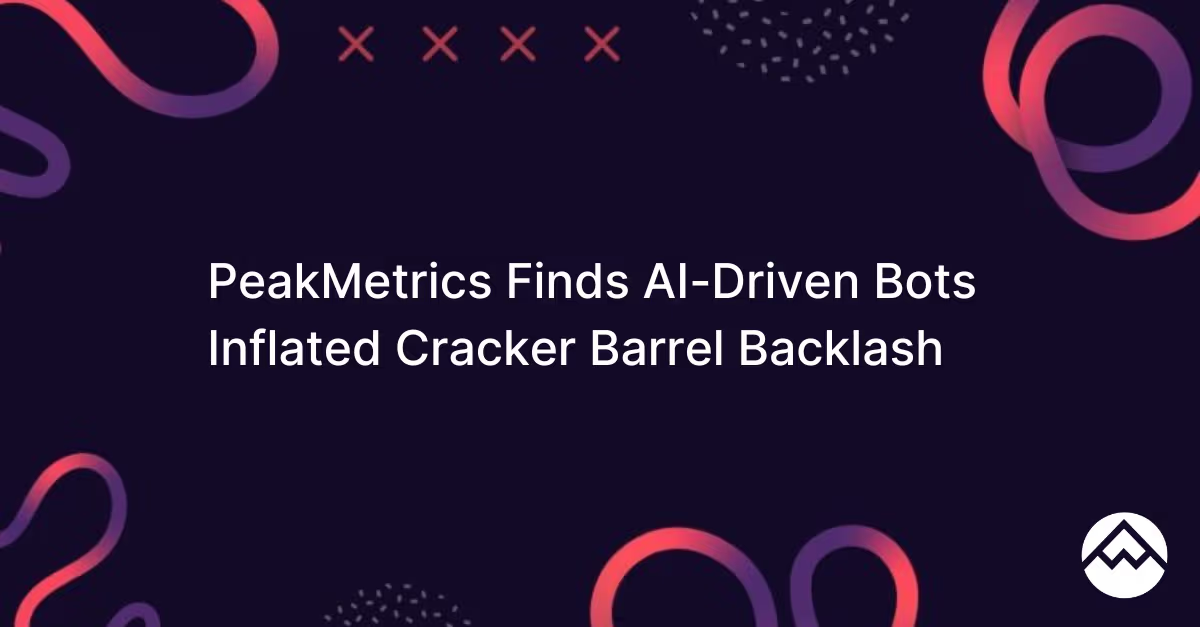
PeakMetrics Finds AI-Driven Bots Inflated Cracker Barrel Backlash
On August 19, Cracker Barrel introduced a refreshed logo. Within hours, the rollout ignited an online uproar. Posts on X (formerly Twitter) surged with outrage, memes, and boycott calls, quickly reframing the update as a culture-war issue.
PeakMetrics’ analysis, shared exclusively with The Wall Street Journal, shows the backlash was not entirely organic. In a sample of 52,000 posts on X from the first 24 hours, 44.5 percent showed signs of bot-like activity, including 49 percent of boycott-specific posts. Looking at the broader conversation between August 19 and September 5, when more than two million posts referenced Cracker Barrel, 24 percent carried signs of automation. The controversy was not just loud; it was inflated by AI-driven networks that dragged Cracker Barrel into a polarized debate at internet speed.
This incident underscores a larger trend. Bots are fabricating and amplifying polarizing conversations at scale, leaving brands vulnerable to being defined by narratives they never intended to spark.
Key Findings
- PeakMetrics examined a sample of 52,000 posts on X from the first 24 hours following the logo reveal.
- Within that dataset, 44.5 percent were flagged as likely automated, including 49 percent of boycott-related mentions.
- From August 19 to September 5, the broader conversation swelled to more than two million posts.
- Roughly 24 percent of those posts displayed markers of automation, showing that while authentic voices were present, bots played a major role in amplifying the backlash early on.
How the Outrage Was Manufactured
The anatomy of the backlash followed a seeder-and-swarm pattern. Human-operated meme and activist accounts, such as @amuse and @PlanetOfMemes, were among the first high-follower accounts to frame the logo change as “woke” and inauthentic. Once seeded, the narrative spread rapidly through bot amplification. Seventy percent of boycott posts used identical phrasing, a clear marker of templated content flooding the platform. A subset of super-repeater accounts pushed the same boycott message 10 to 20 times each, ensuring it dominated feeds.
This activity reached its peak in the first 24 hours after the logo launch, driving the controversy to its highest visibility by August 21. Bots did not originate the dissatisfaction, but they manufactured its scale and created the appearance of a sweeping grassroots movement.
Why It Matters
The bot-driven amplification turned what might have been a conversation about branding into a political skirmish. Posts recycled the familiar “go woke, go broke” rhetoric. Others accused the company’s leadership of abandoning tradition, called for the removal of the CEO, and demanded that Cracker Barrel reverse its decision and return to its “heritage roots.”
PeakMetrics found no evidence of foreign state involvement in the campaign. The initiators are ideological activist accounts with prior culture-war posting histories, supported by botnets.
A Growing Trend
Cracker Barrel is not alone. We are seeing more brands pulled into the political spotlight following branding or policy decisions. American Eagle faced similar dynamics earlier this year when its partnership with Sydney Sweeney sparked backlash over an ad campaign.
Target also experienced sustained boycotts after rolling back parts of its DEI efforts earlier this year. What began as an internal business decision quickly escalated into a months-long public controversy, amplified online and reframed as a cultural battle.
These cases show a consistent pattern: everyday brand decisions are being reframed into political flashpoints. The difference now is that AI-driven bots can amplify these narratives at scale, making them appear larger and more urgent than they truly are.
What It Means for Brands
The Cracker Barrel episode reveals a new reality for corporate leaders. Outrage can now be engineered. Bots can take a handful of critical posts and inflate them into what appears to be a brand crisis. Brand decisions that seem unrelated to politics, like updating a logo, can be dragged into culture wars overnight. And the sheer volume of posts makes it difficult to separate authentic customer sentiment from manufactured noise.
As PeakMetrics’s Director of Insights, Molly Dwyer, told The Wall Street Journal, “Executives should consider any decision they make a potential tool for activity designed to heighten negative engagement on social media.”
The Takeaway
The Cracker Barrel backlash is a warning to every brand. In the AI era, companies are one decision away from becoming a political football. Bots and activist accounts can manufacture outrage at speed and scale, exposing leaders to reputational risk and forcing them to respond to narratives that may not reflect reality.
Traditional monitoring tools, which focus on volume and sentiment, are no longer enough. What matters now is the ability to see through the noise, to identify what is authentic and what has been amplified, and to understand what those narratives mean for the brand. Without that clarity, leaders risk making decisions based on distortion rather than truth.
In today’s manipulated internet, it only takes a handful of accounts and a swarm of bots to transform a logo reveal into a reputational crisis.
Sign up for our newsletter
Get the latest updates and publishings from the PeakMetrics investigations team.